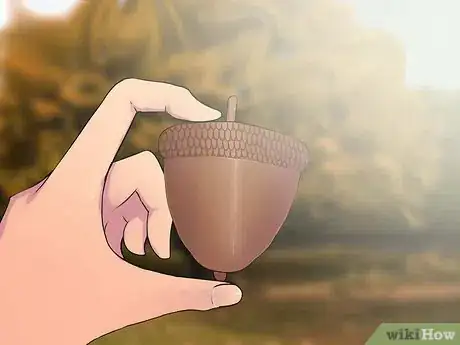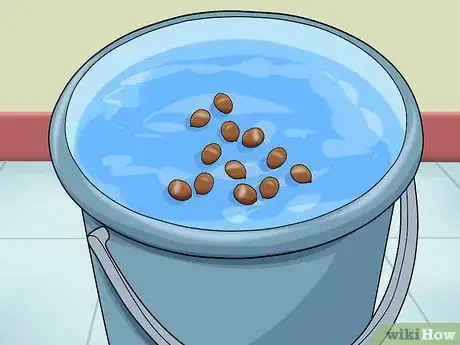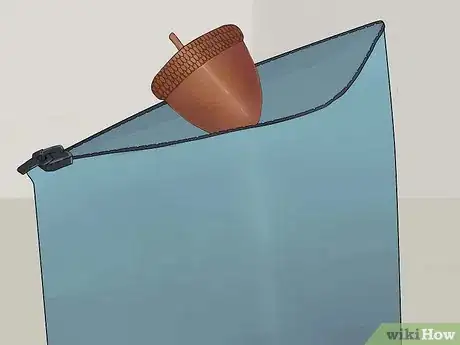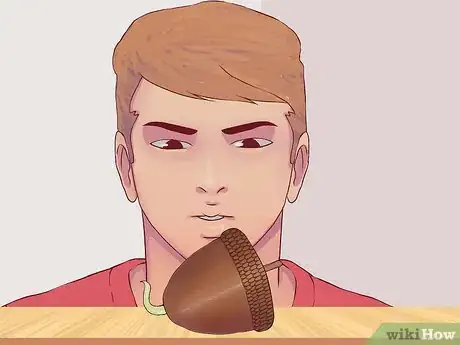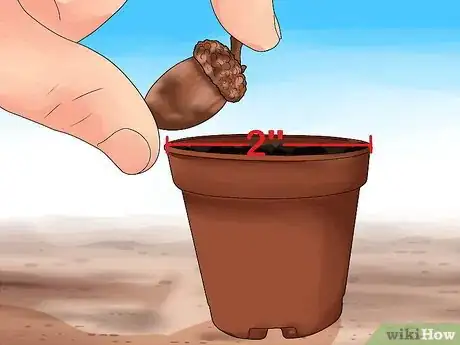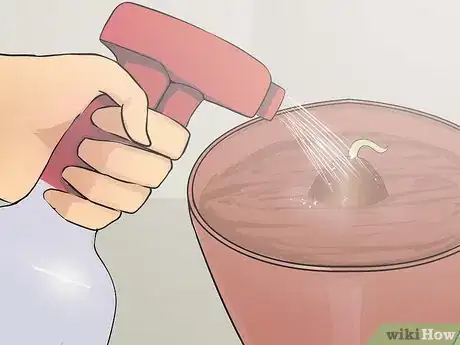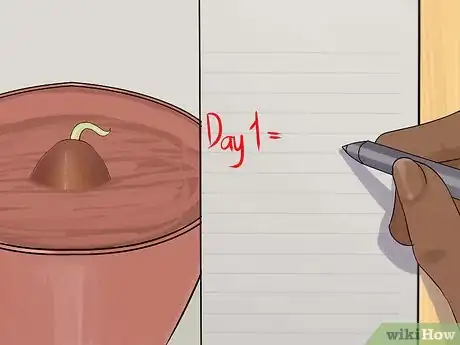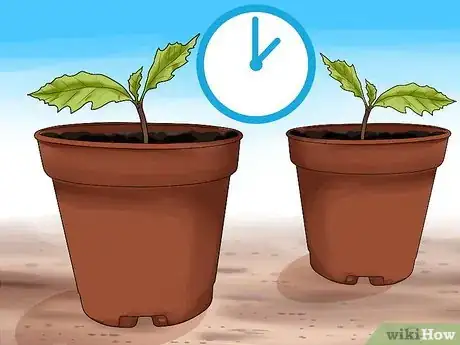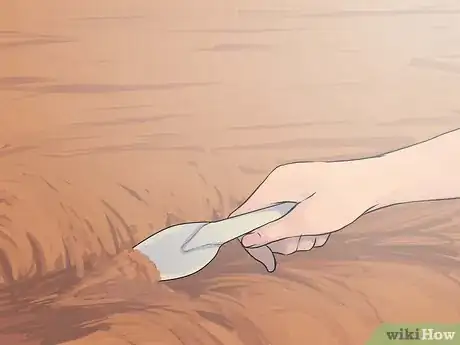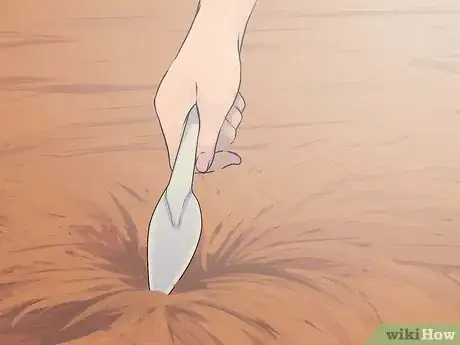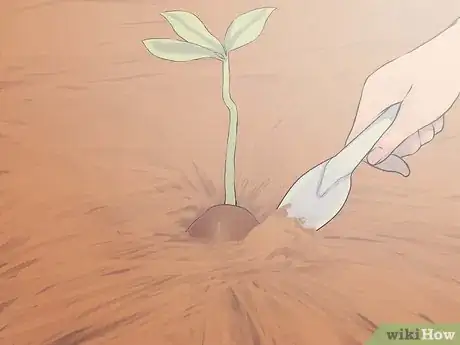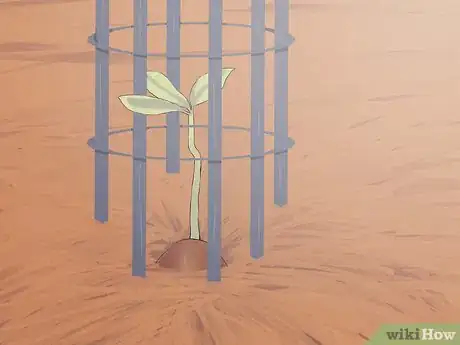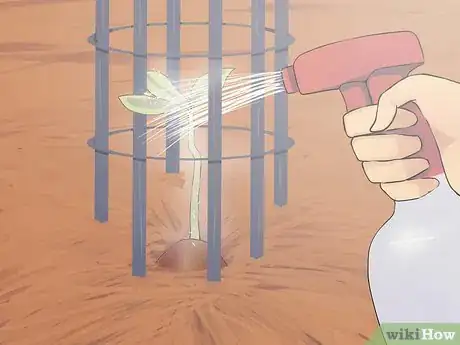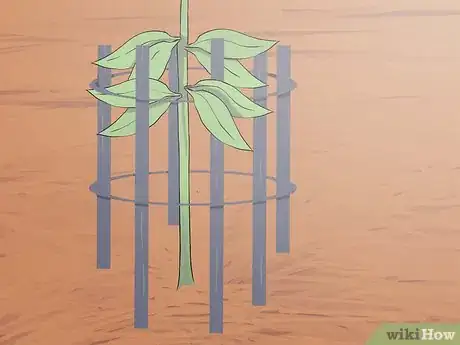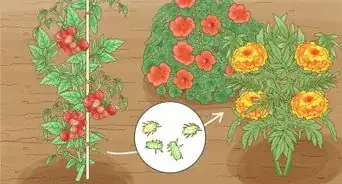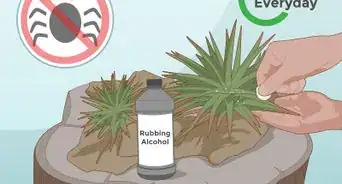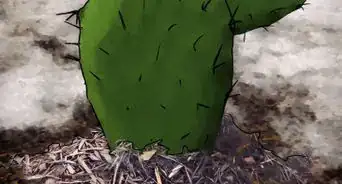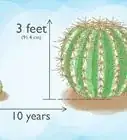This article was co-authored by Lauren Kurtz. Lauren Kurtz is a Naturalist and Horticultural Specialist. Lauren has worked for Aurora, Colorado managing the Water-Wise Garden at Aurora Municipal Center for the Water Conservation Department. She earned a BA in Environmental and Sustainability Studies from Western Michigan University in 2014.
wikiHow marks an article as reader-approved once it receives enough positive feedback. This article received 30 testimonials and 92% of readers who voted found it helpful, earning it our reader-approved status.
This article has been viewed 1,854,623 times.
It’s hard to imagine that a mighty oak tree can come from a tiny acorn, but with enough patience, you can grow one yourself! Look for an acorn to plant in early autumn, germinate it, and start it in a container. Then, transplant your acorn in a prepared site. Care for your growing oak tree so that future generations can enjoy it for years to come!
Steps
Choosing and Planting Acorns
-
1Collect acorns in early autumn. Acorns are best harvested in the early-to-mid autumn before they have fallen from the tree.[1] Choose acorns that are free of worms, holes, and fungus. Suitable acorns should be brownish with slight tinges of green remaining,[2] though the appearance of acorns can vary based on the type of oak tree they come from. A good general rule is that acorns are ready for picking when they can be removed from the cap without tearing them.[3]
- Note that the cap is not part of the acorn, but a (separate) protective covering. By removing the acorn from the cap you are not damaging it unless you tear the acorn itself.
- If possible, look for suitable trees in the summer. You'll want mature trees whose acorns are easily-reached via ladder or with a long pole.
- Some oak varieties, like red oaks, have acorns that take two years to mature, rather than one. As you pick suitable trees in the summer, keep this in mind - the acorns on some oaks will be ready in the fall, while others won't be ready until the following year.
-
2Perform a "float test." Put the acorns that you've harvested, without caps, in a bucket of water. Allow the acorns to settle a minute or two. Discard any acorns that float - these acorns are bad.[4]
- An acorn may float because a worm or grub has burrowed into it, creating an air hole. Similarly, a fungus can make the acorn float.
- If, at any point, you notice that an acorn is soft to the touch, discard it as well. Soft, mushy acorns are rotten.
Advertisement -
3Hibernate the remaining acorns. Take the "good" acorns out of the water and dry them off. Place them in a large zipper bag with damp sawdust, vermiculite, peat mix, or another growth medium that can hold moisture. You should be able to fit up to 250 acorns in especially large bags. Put the bag in the refrigerator for a month and a half or longer - as long as is needed to germinate the new oak.
- This process is known as stratification, which is simply exposing a seed to cold temperatures, mimicking the natural conditions that a seed would experience had it fallen to the ground. This primes the seed for sprouting in the spring.
- Periodically check on your acorns. The medium should be just barely moist. Too moist, and the acorns may rot. Too dry, and they may not grow.
-
4Keep an eye on the growth of your acorns. Even when stored in the refrigerator, most acorns will begin to germinate in the presence of moisture. The root end may begin to crack through the shell around early December (late fall, early winter). Whether or not the root has cracked through, the acorn is ready to be planted after about 40-45 days of storage.
- Handle your seedlings with care - the emerging roots are easily damaged.
-
5Plant each acorn in a pot or container. Obtain fairly small 2 inch (5 cm) diameter gardening pots (or, if you prefer, large styrofoam cups or milk cartons), for your plants. Fill these with a good quality potting soil (some sources also recommend adding milled sphagnum moss[5] ). For watering purposes, leave about an inch (2.5 centimeters) of space at the top. Plant your acorn just below the surface with the root facing down.
- If using a styrofoam cup or milk carton, poke holes in the sides of the cup near the bottom so that water can escape.
- If you prefer, you can also try just burying the acorn in the yard. Bury the root in a shallow hole and gently tuck the acorn to one side on top of suitable rich, soft soil. This will only work if the taproot is already well established, long, and has detached adequately from the acorn. Be warned - this leaves the seedling vulnerable to mice, squirrels, etc. It's best to wrap a cage around the seedling to protect it from animals.
-
6Water your seedling. Water your plant until water comes out of the holes at the bottom of its container. In the coming weeks, water frequently, never allowing the soil to dry out. In this stage of their life, keep your seedlings indoors. Place them on a southern windowsill, where they can absorb the winter sun. You may not notice rapid above-ground growth right away. This is because, during the first stage of its life, the plant is developing its taproot below the surface of the dirt.
- If you live in the southern hemisphere, place your seedlings on a northern windowsill instead.
- If your seedling isn't getting much sun, use a supplemental indoor grow light to provide more sunlight.
Transplant Your Seedling
-
1Track the plant's growth. Gardening sources differ about the next steps to take - some recommend planting seedlings directly into the ground after a few weeks of growth in a pot or cup[6] , while others recommend gradually increasing the amount of each day that the plant is exposed to the outdoor weather before finally planting it in the ground.[7] Still others recommend transplanting the seedling to a larger pot, allowing it to grow further, and then finally planting it in the ground. Though there is no single right way to decide when to transplant a seedling into the ground, there are qualities to look for which can inform your decision to transplant your seedling. Good candidates for transplanting:
- Are about four to six inches tall (10 - 15 cm), with small leaves.
- Have white, healthy-looking roots.
- Appear to be outgrowing their container.
- Have shown substantial taproot growth.
- Are a few weeks to several months old.
-
2Harden off your seedlings before you plant them outside. Putting your seedlings outside without getting them accustomed to the outdoors can kill your plant. About a week or two before planting your seeds outside, place your seedlings outdoors for a few hours. Slowly increase how long you leave the seedlings outside each day for the next week or two. Then, your seedlings will be ready to be planted outdoors.
- Make sure your seedlings are protected from the wind so they don't blow over.
-
3Choose a site for planting. Location is everything - pick a location for your oak tree where it has room to grow and won't be a hindrance when they've grown large. When choosing the site for your oak tree, some things to consider are:
- The availability of sunlight. Like all photosynthetic plants, oaks need sunlight to survive, so don't plant them in shaded areas.
- The location of nearby sidewalks, water lines, buried pipes, etc. You don't want to have to kill your tree if work needs to be done in your yard.
- The shading effect of the full-grown tree. If you would like your oak tree to eventually provide shade for your home, plant it to the west or southwest of your home to maximize the shading effect it will have in the summer, while minimizing its shade in the winter.[8]
- Note - in the southern hemisphere, the tree should be to the west or northwest side of your house to get the shading effect.
- Nearby vegetation. Plants compete with each other for sun, moisture, and other resources. Don't plant your young oak right next to any substantial vegetation, or it may not reach maturity.
-
4Prepare the site for planting. When you've picked a good spot for your tree, clear any minor vegetation in a 3-foot (.9 meter) circle away. Use a shovel to turn over the dirt in the area to a depth of about 10 inches (25 centimeters), breaking up any large clods.[9] If the soil isn't moist, you may want to moisten the soil yourself or wait until after a rain to plant your tree.
-
5Dig a hole. In the middle of your 3-foot (.9 meters) circle, dig a hole about a foot or two deep (61cm-91cm) and a foot (30cm) wide. The precise depth of your hole will depend on the length of your seedling's taproot - it should be roughly deep enough to accommodate it.
-
6Transplant your oak. Taproot facing down and leaves facing up, gently place your oak into the hole you've prepared. Make sure the hole is deep enough to accommodate the oak's roots. Replace the dirt around the plant, packing it in lightly. Water your seedling after planting it.
- Pack soil around the oak seedling, sloping the soil away from the seedling so that water does not sit at the trunk of the tree, which can be damaging.
- Lay a circular ring of mulch about one foot (.3 meters) around the tree to help the soil retain moisture and discourage the growth of weeds. Make sure it does not touch the stem of the tree.
- To increase the chances of a successful planting, you may want to place several acorns in the same area. In this case, plant young seedling acorns directly into the ground by clearing a 2x2 foot (61 cm x 61 cm) area and placing two acorns into that space, with one or two inches (2.5 cm - 5 cm) of soil on top.
Caring for Growing Oaks
-
1Protect young oak trees. Oak trees - especially young, fragile ones - are a source of food for many herbivorous animals. Acorns are a frequent snack for squirrels and mice, who can easily dig them up. Small seedlings are also vulnerable to rabbits, deer, and other animals that like to eat leaves. To ensure your young oak trees aren't devoured, take steps to protect them. Cage your young trees with chicken wire or sturdy plastic fencing around their stem to prevent animals from reaching them.
- If you live in an area where deer are common, you may even want to consider caging the top of the tree.
- You may also want to use pesticides to protect your tree from a variety of pests, including aphids and June bugs. Use caution when selecting pesticides - only use ones that are not harmful to your oak tree or your family.
-
2Irrigate trees in dry weather. An oak's long taproot allows it to draw moisture from deep soils even when surface soils have been completely dried out. During the winter and wet months, it's not usually necessary to water your oak trees. However, when oaks are young, hot and dry weather can be damaging. A drip irrigation system is a useful way to get water to young oak trees when they need it most. Irrigate your tree with about 10 gallons (38 liters) of water via drip irrigation system every week to two weeks. Irrigate during the hottest and driest months for about two years, lessening the irrigation frequency as the tree grows.
- Remember not to allow water to collect around the base of the tree.[10] Arrange your irrigation system so that water drips around the tree, not directly onto its base, where it can cause rot.
-
3Taper your care off as the tree grows. As your oak grows and its roots deepen, you will need to care for it less and less. Eventually, it will be big and tall enough that animals won't be able to kill it and its roots will be deep enough for it to survive the summer without any watering. Slowly, over several years, reduce the amount of care you give your tree (which, aside from watering during dry months and protecting it from animals, should not be all that much). Eventually, your tree should be able to thrive on its own without showing any signs of distress. Enjoy the lifelong gift you've given yourself and your family!
- Within 20 years, your oak may begin producing acorns of its own, though, depending on the species, optimal acorn growth may not occur for up to 50 years.
Expert Q&A
-
QuestionCan you use just the seed or do you need the whole acorn?
 Lauren KurtzLauren Kurtz is a Naturalist and Horticultural Specialist. Lauren has worked for Aurora, Colorado managing the Water-Wise Garden at Aurora Municipal Center for the Water Conservation Department. She earned a BA in Environmental and Sustainability Studies from Western Michigan University in 2014.
Lauren KurtzLauren Kurtz is a Naturalist and Horticultural Specialist. Lauren has worked for Aurora, Colorado managing the Water-Wise Garden at Aurora Municipal Center for the Water Conservation Department. She earned a BA in Environmental and Sustainability Studies from Western Michigan University in 2014.
Professional Gardener You don't need the cap of the acorn. The seed is the lower part of the acorn, and you just need to plant that.
You don't need the cap of the acorn. The seed is the lower part of the acorn, and you just need to plant that. -
QuestionCan I trim the top down to produce more limbs on a 3 year old oak tree?
 Lauren KurtzLauren Kurtz is a Naturalist and Horticultural Specialist. Lauren has worked for Aurora, Colorado managing the Water-Wise Garden at Aurora Municipal Center for the Water Conservation Department. She earned a BA in Environmental and Sustainability Studies from Western Michigan University in 2014.
Lauren KurtzLauren Kurtz is a Naturalist and Horticultural Specialist. Lauren has worked for Aurora, Colorado managing the Water-Wise Garden at Aurora Municipal Center for the Water Conservation Department. She earned a BA in Environmental and Sustainability Studies from Western Michigan University in 2014.
Professional Gardener No, you should never damage the leading branch. This will damage the tree's appearance and make it vulnerable to disease. It's better to plant a variety of oaks, including scrub oak or a gambel oak, which will branch low or look more like a shrub.
No, you should never damage the leading branch. This will damage the tree's appearance and make it vulnerable to disease. It's better to plant a variety of oaks, including scrub oak or a gambel oak, which will branch low or look more like a shrub. -
QuestionCan I leave the acorn in the refrigerator for longer than a month and a half?
 Community AnswerYes, but keep an eye on them for the roots.
Community AnswerYes, but keep an eye on them for the roots.
Things You'll Need
- Acorns (green)
- Plastic bag
- Refrigerator
- Sawdust
- Pot for growing
- Suitable soil
- Watering can
References
- ↑ http://ca.audubon.org/how-plant-oak-tree-acorn
- ↑ http://phytosphere.com/oakplanting/acorns.htm
- ↑ http://ca.audubon.org/how-plant-oak-tree-acorn
- ↑ http://phytosphere.com/oakplanting/acorns.htm
- ↑ http://www.wildbirds.org/oaks/oaks.htm
- ↑ http://ca.audubon.org/how-plant-oak-tree-acorn
- ↑ http://www.wildbirds.org/oaks/oaks.htm
- ↑ http://phytosphere.com/oakplanting/acorns.htm
- ↑ http://phytosphere.com/oakplanting/acorns.htm
About This Article
Before you plant your acorns, place them in a bowl of water, and discard any that start to float after 2 minutes. Place the rest in a sealed plastic bag filled with vermiculite or peat mix and store it in the refrigerator for 45 days. If you find one that has sprouted, place it root-side-down in a small pot full of damp soil and water thoroughly. Tend to your acorn as it grows, then transplant the tree outside when it is 4–6 inches (10–15 cm) tall. For tips on where to plant your new oak tree, read on!
